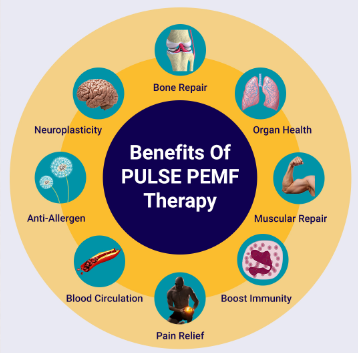PEMF Therapy for Injury Recovery, Depression, Anxiety, and Exercise Recovery
What is PEMF Therapy?
Pulse Electro Magnetic Field (PEMF) therapy is a non-invasive treatment that uses low-level electromagnetic fields to promote healing and reduce pain. PEMF therapy has been shown to be effective in a variety of conditions, including depression, anxiety, injury recovery, and exercise recovery.
How Does PEMF Therapy Work?
PEMF therapy works by stimulating the body’s cells and tissues. The electromagnetic fields penetrate the body and create a cascade of biochemical reactions that promote healing and reduce pain.
Do PEMF devices really work?
There is scientific evidence to suggest that PEMF devices can be effective in treating a variety of conditions, including pain, inflammation, and depression. The scientific evidence for PEMF therapy is based on the theory that the electromagnetic fields emitted by PEMF devices can interact with the body’s cells and tissues, stimulating them to repair themselves. The currents induced in tissues by PEMF mimic the natural electrical activities created within bones during movements. This may help to improve circulation, reduce inflammation, and promote healing.
What are the risks of PEMF therapy?
The risks of PEMF therapy are very low. Some people may experience mild side effects, such as headache or nausea. However, these side effects are usually mild and go away on their own.

Benefits of PEMF Therapy for injury and exercise recovery.
- Assist with muscle fatigue after exercise: PEMF therapy can help to reduce muscle fatigue after exercise by increasing blood flow and oxygen delivery to the muscles.
- Support general relaxation: PEMF therapy can help to promote general relaxation by reducing stress and anxiety.
- Experience more energy overall: PEMF therapy can help to increase energy levels overall by improving cellular function and metabolism.
- Accelerate the healing of injuries: PEMF therapy can help to accelerate the healing of injuries by stimulating the production of new cells and tissues.
- Improve range of motion: PEMF therapy can help to improve range of motion by reducing pain and inflammation.
- Reduce pain: PEMF therapy can help to reduce pain by stimulating the release of pain-relieving chemicals in the body.
How long does PEMF therapy last?
The length of PEMF therapy varies depending on the condition being treated. However, most PEMF therapy sessions last for 15-30 minutes.
How many PEMF therapy sessions do I need?
The number of PEMF therapy sessions needed also varies depending on the condition being treated. However, most people need 10-15 PEMF therapy sessions.
Is PEMF therapy covered by insurance?
Insurance coverage for PEMF therapy varies. Some insurance companies may cover PEMF therapy if it is prescribed by a doctor. However, most insurance companies may not cover PEMF therapy.
Who should not use PEMF?
PEMF therapy is generally safe for most people. However, there are a few groups of people who should not use PEMF therapy, including:
- People with pacemakers or other electrical implants: The electromagnetic fields emitted by PEMF devices can interfere with the function of pacemakers and other electrical implants.
- Pregnant women: The safety of PEMF therapy during pregnancy has not been established.
- People with active bleeding: The electromagnetic fields emitted by PEMF devices can slow down blood clotting.
- People with certain medical conditions: If you have a medical condition, talk to your doctor before using PEMF therapy.
Is PEMF the same as TENS?
- PEMF (pulsed electromagnetic field) therapy and TENS (transcutaneous electrical nerve stimulation) therapy are both non-invasive pain relief treatments. However, they work in different ways.
- TENS therapy uses electrical currents to stimulate the nerves, which can block pain signals from reaching the brain. PEMF therapy uses electromagnetic fields to stimulate the body’s cells and tissues, which can promote healing and reduce pain.
